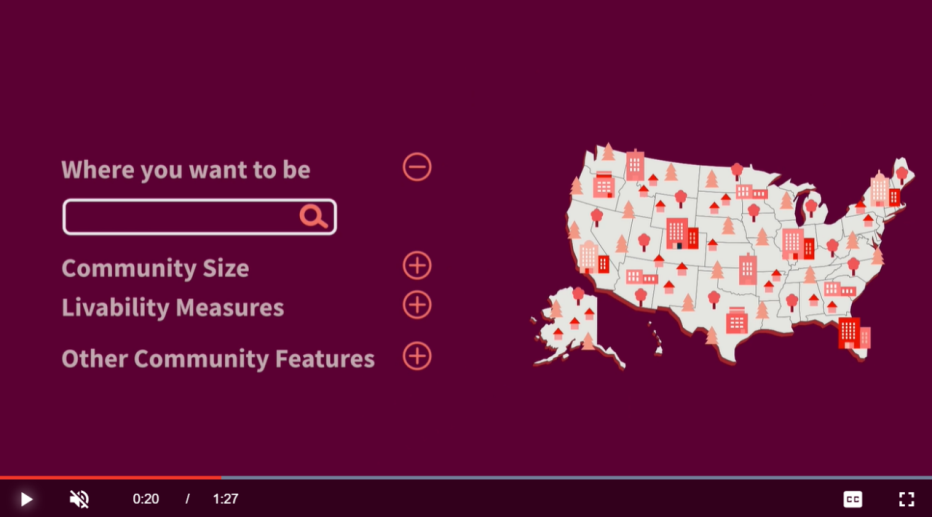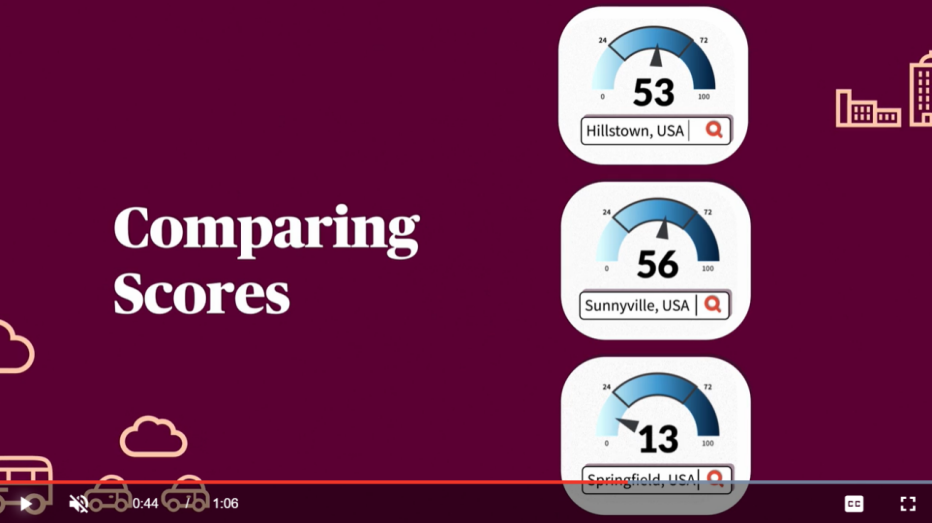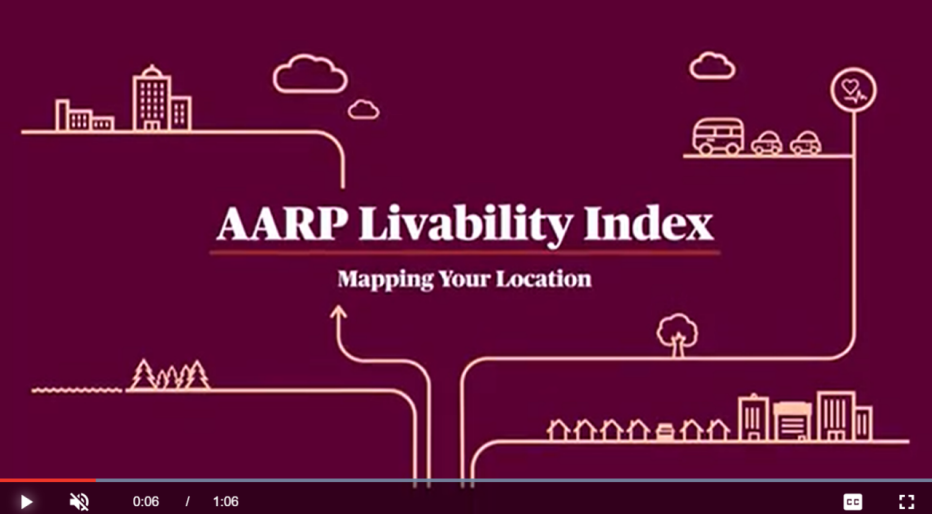AARP Hearing Center
The AARP Livability Index™ platform is a signature initiative of the Public Policy Institute (PPI) to measure the quality of life in American communities across multiple dimensions: housing, transportation, neighborhood characteristics, environment, health, opportunity, and civic and social engagement.
An interactive, easily navigated website, the AARP Livability Index™ platform allows community members, policymakers, and advocates to compare communities, adjust scores based on personal preferences and learn how to take action to make their own communities more livable.
Learn more about the top scoring communities in the United States and use the tool by visiting www.aarp.org/livabilityindex
New Features
- Updated Data: The platform uses the latest indicator data for each category of livability with in-depth insights into understanding the data with expanded details of methods and sources.
- Top 100 Communities List: Users can gain new insights by learning about the highest scoring places across the nation leading the way in making communities more livable. The top 100 communities are determined by overall livability score and grouped by population size. The list now includes counties and county subdivisions.
- New Community Characteristic Data: Expanded demographic information to align with the US Census race and ethnicity categories to include population percentages for Native Hawaiian or Other Pacific Islander, Two or More Races, and Some Other Race for each community. This information is not used in determining the community’s score on the AARP Livability Index platform.
- The Categories Explained Fact Sheet Series: A new series of seven fact sheets, one for each category of livability, that breaks down the 61 indicators used to determine a community’s livability scores. The fact sheets are a great outreach tool that can be shared with community members, policymakers, and government officials to provide a clear overview of the key measures that influence livability.
What is the AARP Livability Index™ platform?
The free, online tool helps users better understand their communities and make decisions about future needs.
How can I use the AARP Livability Index™ platform?
The platform may be used in a number of ways.


AARP Livability Index™ Publications and Videos
The AARP Livability Index™ Categories Explained
These seven downloadable fact sheets explain the key measures the platform uses in each of the categories to score and rank neighborhoods and communities across the country.
Overview Brochure of the AARP Livability Index™ Platform
Printable, one-page overview of the platform describing key features and benefits for residents, public leaders, policymakers, and community advocates alike.
2023 Forum: Building Livable Communities for All Generations
AARP and the National Housing Conference (NHC) co-hosted “Building Livable Communities for All Generations,” an event to unveil the latest iteration of the AARP Livability Index™ platform and discuss the importance of creating communities that are safe, accessible, and inclusive for all ages and backgrounds.
Empowering People to Remain Independent
An inside look at how the St. Charles community empowers members to live independent lives with the help of volunteer driver transportation.
A North Carolina ADU Story: Keeping Family Close By
See how one family and a Durham community turned to accessory dwelling units (ADUs) as an affordable housing option.
Connecting Rural Arkansas via High-Speed Internet
A look at how community, business, and government leaders brought internet service to unserved businesses and homes in a south Arkansas community.
2022 AARP Livability Index Week Launch Webinars
See a demonstration of the new site and the latest updates and hear from the experts and project team behind the AARP Livability Index™ platform on three of the seven areas of livability—Housing, Transportation and Engagement.
Which Older Adults Have Access to America’s Most Livable Neighborhoods?
This report combines what AARP Livability Index™ data tells us about neighborhoods with what the American Community Survey tells us about who lives there.
The Livability Index™ 2018: Transforming Communities for All Ages
Many US cities are becoming more livable as the Midwest embraces complete streets policies and the South passes no smoking ordinances. Yet, paradoxically, sprawl continues. Those are just a few of the compelling trends highlighted in analysis of data from the 2018 Livability Index™ platform.
Is This a Good Place to Live? Measuring Community Quality of Life for All Ages
This report explores the meaning of livability, examines previous efforts to evaluate the livability of communities and describes lessons learned by PPI as part of its work to measure community livability.
What is Livable? Community Preferences of Older Adults
This report highlights findings from a PPI survey of more than 4,500 adults age 50 and older to understand general preferences for community livability and how those preferences differ within the diverse population of older adults, including age, income, physical ability, driver status, race and ethnicity, and other factors. Rodney Harrell, Ph.D., vice president of the AARP Public Policy Institute's family, home, and community initiative, discusses the "What is Livable?" survey results.
You May Also Like
- Top 100 Places to Live in the U.S. for Older Adults (2024)
- AARP Relaunches its Livability Index to Reveal America’s Top-Scoring Cities and Towns in 2022
- The New AARP Livability Index: High-speed Internet Access Is an Indicator of Community Livability
- The New AARP Livability Index: ADUs Provide Possibilities for Now, and the Future
- The Livability Index Equips REALTORS® with Vital Neighborhood Data
- Where We Live, Where We Age: Trends in Home and Community Preferences
- Communities Are Embracing Development Near Transit: A Snapshot of Transit-Oriented Development Support across the United States
- Housing Policy Solutions to Support Aging with Options
- A-Z Livability Archives



































































